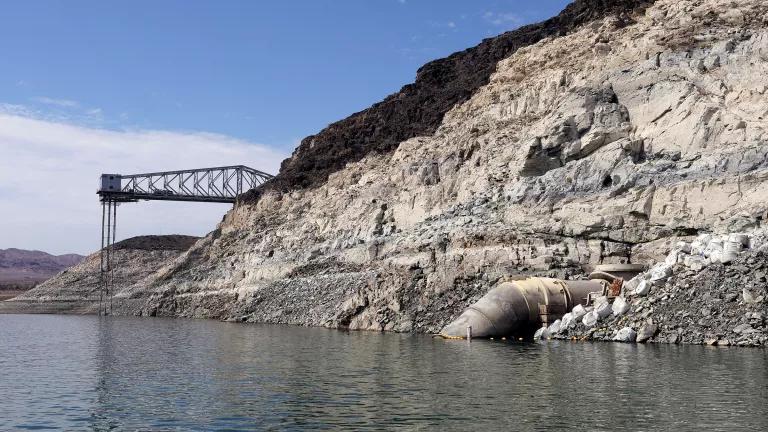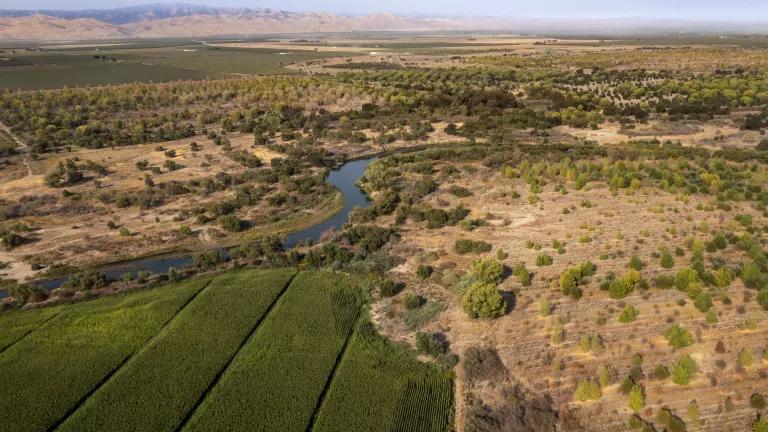California's Colorado River Reckoning
If you thought the consequences of climate change could be left to your children and grandchildren to deal with, 2023 will bring a different message. The era of the Colorado River as a security blanket for Southern California is over.

Lake Mead at Saddle Island on July 28, 2022, at its lowest since being filled in 1937 after the construction of the Hoover Dam.
2023, and every year that follows, will be different for the seven Colorado River Basin States—and particularly for Southern California. In June, the Commissioner of the Bureau of Reclamation, operator of the massive federal dams on the Colorado River, informed the seven states of the Colorado Basin that they needed to prepare for reductions of 2 to 4 million acre-feet of Colorado River water next year, or as much as 1/3 of the amount used in a typical year. Sharply declining water levels behind both Hoover Dam and Glen Canyon Dam have raised alarms about the system’s ability to continue to supply water and power, forcing the states to consider what was previously unthinkable. The Commissioner is expected to announce more specifics in August. While each of the Basin states will face challenges, this blog focuses on California, which has never had to contend with a curtailment of its original apportioned share of the Colorado.
How did we get here?
For more than a century, the Colorado River has been Southern California’s ace in the hole. It is not the only source of imported water to be sure, but it has long been seen as the most reliable. California interests exploited the Lower Colorado in the early 1900s and protected their claims on river water through interstate negotiations a century ago. Drawing from a vast watershed and converted into a gigantic water storage system by huge federal dams, the supply of Colorado River water seemed assured. Indeed, water was so abundant for so many years that California routinely drew much more than its allotted share until the demands of other states finally caught up in 2003, and California was forced to stay within its original annual allotment of 4.4 million acre-feet.
But the dry conditions that have prevailed since 1999 have taken their toll. Lake Mead and Lake Powell are each less than 28% full, and their decline has been accelerating this year. When the first shortage declaration for Lake Mead was made in 2021, California was spared while Nevada and Arizona were curtailed for 2022. Not so this time around. The need for reductions of 2 to 4 million acre-feet next year cited by the Commissioner virtually ensures that California is in store for a substantial cut.
The writing has been on the wall for some time. It was long known that the Colorado was over-allocated during the interstate compact negotiations of the 1920s, and that the Basin states and the Bureau of Reclamation remained willfully blind to this reality for decades. Numerous studies, scientists, and engineers warned that diversions from the Colorado were unsustainable. Yet as recently as last year, the Metropolitan Water District continued to overestimate its reliable draw of Colorado River water.
Ten years ago, the Bureau, in cooperation with the basin states, completed the Colorado River Basin Water Supply and Demand Study. This 2012 report was the first comprehensive effort by state and federal agencies to factor the impacts of climate change into long-term projections for the basin. While many scenarios were evaluated, the trend was clear. A comparison of the median water supply projections against the median water demand projections showed a projected imbalance in supply and demand reaching 3.2 million acre-feet by 2060.
Since that time, California has taken a number of steps to rein in unnecessary water use in urban areas through stronger standards and financial incentives for more efficient plumbing fixtures, appliances, and newly installed landscapes. While progress has been uneven, per capita residential water use has trended down. However, urban users draw about 25% of California’s Colorado river water, while agriculture takes the rest. In recent decades, investments in agricultural water efficiency have been directed more toward projects that facilitate transfers to urban water users, rather than any net reduction of the state’s reliance on the Colorado.
Where do we go from here?
Once the 2023 curtailment is determined, state leaders and stakeholders will have limited time to ponder and process the seismic shift that is taking place. In an ideal world, major cuts in water use would be phased in over a decade or more, with accommodations and adjustments made at a manageable pace. But that ship has sailed. The consequences of our changing climate foreseen for 2060 have arrived sooner than expected. Policy choices will be challenging, to say the least, and a soft landing for every impacted water user may not be obtainable in the near term.
How big is the challenge? As the largest user of Colorado River water by far, California must anticipate taking a full and fair share of reductions. In broad strokes—subject to refinement through further analysis, and assuming the full 4 million acre-feet per year of reduced water diversions—California should probably be aiming to reduce its draw on the Colorado by at least 1/3, to a level of about 3 million acre-feet per year. More water may be available in some wet years, but recurring withdrawals by cities and farms need to substantially contract to a more sustainable level. And of course, reductions of this magnitude must be accompanied by other Basin states taking their fair share of reductions as well.
Getting there must involve both the urban and agricultural sectors. And 2023 should mark the beginning of permanent reductions in Colorado River withdrawals, not simply the adoption of short-term expedients, such as temporary fallowing of irrigated land.
The road to sustainability will probably involve most of the following actions:
Reduce agricultural water consumption through:
- more widespread and ambitious irrigation efficiency
- shifts away from low-value water-intensive forage crops, and
- retirement of the least productive and least suitable lands owned or operated by corporate agribusiness, perhaps 10% to 15% of land currently irrigated with Colorado River water.
Reduce urban water consumption through:
- more thorough and equitable application of conservation and efficiency measures, such as those previously highlighted here, including a major reduction in ornamental (non-functional) turf
- recycle and reuse at least half of all treated sanitary flows that now reach the ocean, and
- capture and reuse at least half of coastal stormwater runoff.
Of course, bad ideas will certainly have their advocates. Policymakers should turn away from:
- attempting to make up the curtailment of Colorado River water with increased diversions from the Bay-Delta system
- attempting to make up the curtailment of Colorado River water with costly ocean desalination, which will drive up energy use and the cost of water for those contributing least to the problem and will harm coastal ecosystems.
Such momentous decisions ought not be made in secret negotiations among water agencies. Unfortunately, the state’s formal administrative forum for these issues—the Colorado River Board of California—is currently hobbled by vacancies. Nevertheless, a full range of voices should be heard, from representatives of farm laborers and small businesses to managers of industrial facilities and yes, golf courses. Retirees on fixed incomes and working single mothers need to know that water will be affordable. Fire fighters and hospitals need to know that water will be reliable. And collapse of the Salton Sea ecosystem must be avoided.
If you thought the consequences of climate change could be left to your children and grandchildren to deal with, 2023 will bring a different message. The era of the Colorado River as a security blanket for Southern California is over, and we need to act now to secure the future of our communities in this new and different climate.




